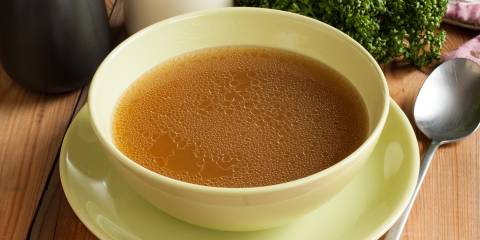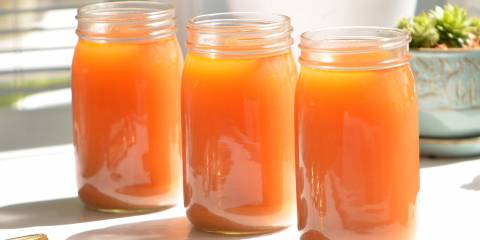The base of many recipes (soups, stews, and sauces), broths add a depth of flavor that makes the time to prepare them worth it. Broth is also rich in nutrients, offers hydration and electrolytes, and supports joint and gut health.
What Is Broth?
Broths are commonly made from vegetables, meat, or seafood.
What's the Difference Between Broth and Stock?
According to food writer Drew Smith, there’s a difference between broths and stocks: “For me, it is a simple distinction. Broth is what we do at home. Stock is what you make for a restaurant. A good broth should be drinkable as it is.”
Whether you decide to sip broths for health benefits or incorporate them into soups or sauces, making your own is a healthy and satisfying activity.
Types of Broth
-
Bone Broth
This type of broth is made from a simple combination of meat bones (such as beef, chicken, or turkey) and water. Vegetables and other aromatics like herbs, spices, garlic, and onion are sometimes added for flavor.
Benefits of Bone Broth
Rich in healing properties, bone broth is a source of nutrients that the body cannot make on its own. The nutrients in bone broth come from the marrow, or soft part of the bone, as well as the outer bone matrix, which is the dense part of the bone.
Iron, phosphorus, calcium, magnesium, and boron are some of the minerals present, depending on the type of broth. Collagen is another nutrient found in bone broth; it helps digestion, encourages wound healing, and promotes healthy skin.
Making Bone Broth
Making a quality bone broth takes time: don’t rush the process. Another helpful tip: don’t boil the ingredients. A vigorous boil causes the fat and impurities to mix back into the broth. This makes it harder to skim and discard them from the broth’s surface. When a broth is boiled, its flavors are not extracted as effectively as when the broth is slowly simmered.
To reach the desired temperature when making a broth, remove the lid or keep the lid slightly tilted so it covers only half the pot. Aim for a few light ripples to appear across the liquid’s surface during the cooking process. If bubbles appear, make sure they’re tiny. Maintain a steady and low heat over medium to medium-low.
For best flavor, remove any foam or fat that appears on the broth’s surface. A flat spoon works well for this task. Keep in mind that the broth may become cloudy during its first hour of cooking. But after a few skimmings of the surface, the broth should become clearer and take on a golden or brown color. If you don’t skim broth (particularly during the first hour), the broth may develop a bitter taste and be cloudy. Allow the broth to cool slightly before straining it.
-
Vegetable Broth
Simple ingredients like vegetables, herbs, and spices can be transformed into vegetarian broths. Consider pea pods, or even the cooking water from cauliflower or chickpeas, to enhance flavor when making vegetable broths.
Making Vegetable Broth
If the vegetables you wish to add are not organically grown, wash and peel them first. Vegetables can be added directly to the cooking water, or they can be sautéed first. The degree to which the vegetables are cooked beforehand influences the broth’s final flavor. If the vegetables are cooked until just limp, there will be a more delicate taste to the broth. If the vegetables are cooked until golden brown in color, a richer flavor will form.
Leave fresh herb bundles whole, and cut vegetables into large chunks when making vegetable broth. Taste the broth as it is cooking. If the flavor becomes too sweet (from too many carrots) or too strong (from an abundance of herbs), scoop out and discard the potent ingredient(s). Add herbs and spices during the final half hour of cooking.
Tips for Making Better Broth
-
Water
-
Use Filtered Water
For premium flavor and the most health benefits, use filtered water when making broth.
-
Use Enough Water
Cover ingredients by two inches with water to gently and thoroughly extract flavors from the ingredients.
-
Use Cool-Temperature Water
Starting off the cooking process with cooler water also ensures bone broths remain clear.
-
-
Seasoning
-
Aromatic Herbs and Spices
Season bone and vegetable broths with your favorite aromatics, like fresh herbs and whole or ground spices. Consider the following:
- basil
- cilantro
- coriander seeds
- cumin seeds
- dill
- fennel seeds
- garlic
- ginger
- leeks
- onion
- oregano
- parsley
- peppercorns
- rosemary
- sage
- thyme
-
Consider Vinegar
Vinegar is another possibility. Apple cider vinegar helps extract more mineral content from the bones when making bone broth.
-
Use Minimal Salt
When seasoning broths, add a minimal amount of salt during the cooking process. If the broth becomes too salty, it’s impossible to remove it. You can always add more later.
-
-
Storage
- Store broths, tightly covered, for three days in the refrigerator.
- Broths may also be frozen up to three months.






